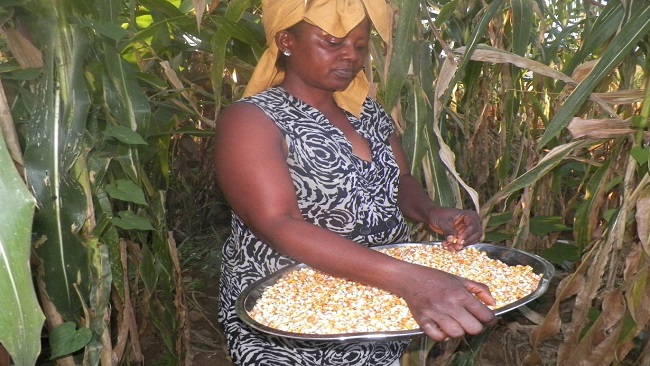Ambazonia conflict turns climate-stressed farmers into ‘food beggars’
John Tabi, a cocoa farmer from Cameroon’s Southwest Region, barely ekes out a living selling water sachets in a refugee camp in Douala, after fleeing a separatist insurgency back home.
The crisis has reduced him and his family of five to “beggars depending on crumbs from humanitarian aid”, Tabi, 52, told the Thomson Reuters Foundation.
“For three years running, I can no longer have access to my cocoa farm, which is my source of income, because of the conflict,” he said.
Thousands of small-scale farmers in Cameroon’s English-speaking Southwest and Northwest regions have been forced off their land by armed conflict between government forces and Anglophone separatists seeking to form an independent state called Ambazonia.
The crisis began with demands by Anglophone Cameroonians for a bigger say in the Francophone-dominated government, sparking strikes and protests in late 2016 and escalating into an uprising a year later.
The resulting conflict has left at least 1,850 people dead and more than half a million displaced inside the country, according to a May 2019 report by Human Rights Watch.
Hospitals and hundreds of villages have been burned, with more than 80 percent of schools closed and 800,000 children deprived of education, according to the United Nations.
The Norwegian Refugee Council has called it the world’s most neglected displacement crisis, edging towards full-blown war.
Meanwhile, abandonment of farms will likely increase hunger and poverty, and cripple the economy, warned Celestin Tawamba, president of the Cameroon Employers’ Association, GICAM.
“The food scarcity in the country since the beginning of the Anglophone crisis is of an unprecedented scale,” Tawamba said in an interview in Yaounde.

TOWNS IN LOCKDOWN
Crops have been left unprotected from the effects of extreme weather, pests and diseases, said Christopher Ekungwe, government delegate for agriculture in the Southwest Region.
“Drought-resistant and improved seeds, fertilisers, spraying machines and other assistance meant for farmers cannot be distributed because of permanent lockdown in most of the towns,” he said.
Farmers said the violence had made it harder for them to cope with climate challenges.
Erratic weather, including prolonged rains, has caused black pods on cocoa trees and blight in some food crops like yams.
Rising temperatures, exacerbated by the rapid disappearance of local forests, have also affected crop yields, they said.
Daniel Elume, a farmer in Mutengene in the Southwest Region, used to apply pesticides to his plantain and cocoyam before the onset of heavy rains.
“This is no longer possible since I cannot access my farm nor get weather-resistant seeds. Everything now has been destroyed,” he added.
More than 560,000 displaced people, mostly women and children, are sheltering in makeshift refugee camps in French-speaking towns in Cameroon and in neighbouring Nigeria, relying on food assistance to survive.
“It’s unfortunate – food producers have become food beggars,” said Mary Ajong, a vegetable farmer from Tiko in the Southwest, now living in Douala.

CLIMATE PROJECTS ON HOLD
Environmentalists say the crisis has brought many projects intended to help farmers fight climate change to a standstill.
Measures in the country’s climate change action plan, submitted to the United Nations under the Paris Agreement, have been halted in these forested and coastal zones because of insecurity, said Zachee Nzohngandembou, head of the Centre for Environment and Rural Transformation (CERUT), a non-profit based in Limbe in the Southwest Region.
They include planned mangrove restoration projects along the Limbe coast, provision of improved seeds and fertiliser to farmers, and renewable energy installations in rural areas.
“We are greatly concerned by the disturbing setback,” Nzohngandembou said.
According to a 2018 GICAM report on the impact of the Anglophone crisis, the Southwest Region is no longer the top cocoa-producing part of the country, with its share of cocoa sales dropping to 32% in the 2017-2018 season from 45%.
Growers lost revenues of close to 3 billion CFA francs ($5 million) – and the decline is set to accelerate this year, the report warned.
State-owned agribusiness, the Cameroon Development Corporation, which employs 22,000 workers in the two affected regions where it has plantations, has seen its operations practically brought to a halt.
Most of its rubber, palm oil and banana plantations covering 42,000 hectares (104,000 acres) in the Southwest have been destroyed, Director-General Franklin Ngoni Njie told reporters this month.
A March report from the U.N. Food and Agriculture Organization also indicated the crisis had led to a significant drop in food production.
Total cereal production for 2018 was estimated to be about 3 million tonnes, or 4 percent below the five-year average.
Poor harvests have also pushed up market prices for staple food crops since January 2017 by more than 25%, consumer association officials said.
An average bunch of plantain that sold at 2,000 CFA francs before the crisis now goes for 3,000 francs, while palm oil prices have risen on local markets by more than 50% as production fell, said Jacquis Kemleu Tchabgou, secretary-general of the Cameroon Vegetable Oil Refiners’ Association (ASROC).
“This has made life difficult not only for those in the affected zones but across the national territory,” he said.
“It has also affected consumers from neighbouring countries like Gabon and Equatorial Guinea, which buy from Cameroon markets.”
Culled from Thomson Reuters Foundation





